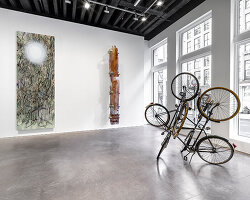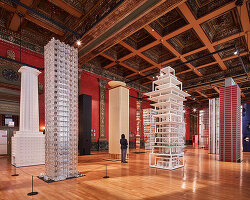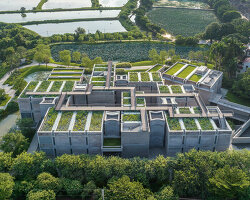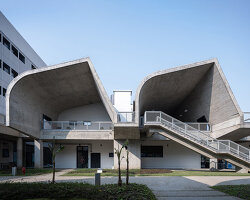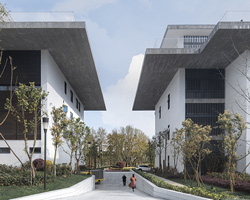yung ho chang, architect + founder of atelier FCJZ portrait © designboom
— designboom met with yung ho chang of atelier FCJZ at his studio in beijing, china. —
designboom: what is the best moment of the day for you?
yung ho chang: the best time is in the morning sitting on the toilet reading half a page of a detective novel I love.
DB: what type of music do you listen to?
YHC: because of my upbringing, I listen to western classical music, especially from the baroque period. I like listening to different versions of pachabel’s canon. on youtube, there is a video of a woman – I think she is french – who is sitting on a piece of rock on the ocean front with a lira playing the canon. it’s really absolutely divine. I also like some of the popular music from the sixties – the beatles, simon and garfunkel and so on…
DB: what types of books are on your bedside table?
YHC: I like to read detective novels. at the moment I prefer reading english novels, but I like the new novels of french writer marguerite duras, and then there’s irish author flann o’brien who I also enjoy. but today, the best detective writer is keigo higashino from japan. there is one book translated into english – ‘the devotion of suspect X’ – that is about the sacrifice of suspicious acts. I highly recommend it.
 ‘the bay’ in qingpu district, shanghai, china see more about this project here
‘the bay’ in qingpu district, shanghai, china see more about this project here
 detail of partition wall bordering courtyard
detail of partition wall bordering courtyard
 entrance courtyard of house ‘B3’
entrance courtyard of house ‘B3’
 view of the water-front house
view of the water-front house
 view of the water-front, suburbia-style neighborhood of courtyard houses
view of the water-front, suburbia-style neighborhood of courtyard houses
DB: fashion wise I see you are very updated.
YHC: I am very eclectic in my style. I don’t really wear business suits. they look elegant on some people, but if I wear a tuxedo to an event, people take me as a waiter which is problematic. they don’t look right on me. I don’t have the attitude for it. actually, we design clothing ourselves. we produce a small amount and they sell quite well in a store in sanlitun called BNC (brand new china). we actually designed the retail space as well.
DB: are your glasses mikli (alain)? YHC: no, these are theo from belgium.
DB: so as you design clothes, how do you prefer a woman to dress?
YHC: men and women have very different personalities. if someone has a really outgoing personality, I don’t think subtle pieces would hide it, but complement it. I am sure some people can wear very loud clothes and that would be alright. in general, my disappointment this year is what raf simons did with all these colors for jil sanders. it’s beautiful, it’sexciting, but for me is she going to come back to what she used to do so beautifully in past years? I guess she’s probably getting a bit bored… but anyways, that’s my little comment about one particular designer. this is not my expertise. I’m just kind of someone who has a hobby, who’s interested in design. I think right now men’s clothing is going through a bit of a liberation, in that men – not me personally – can wear a much bigger range of clothing than ever before, and that this influences women’s wear. like the cigar suit for example. what we wear has become more feminine.
 ‘museum-bridge in anren’ in anren, sichuan, china image © cao, yang see more about this project here
‘museum-bridge in anren’ in anren, sichuan, china image © cao, yang see more about this project here
DB: did you always know you wanted to become an architect? YHC: no, I wanted to be a painter. I grew up in a non-traditional chinese family. my parents’ attitude towards their children was not like the typical chinese parents – they didn’t force me to study. my brother and I would spend our days playing, and since part of our childhood was spent during the cultural revolution, with all of the political troubles, we didn’t have to study. my parents knew I was interested in painting and that I was not very good with mathematics or physics.
when I applied to university right after the cultural revolution in 1977, I realized although I liked to paint, my paintings were terrible. my father even said I wasn’t very good and asked me ‘why don’t you consider my profession?’ (he was an architect). so in my third year of university, I started to develop an interest in it and went to the united states to study. through my education, I started to see my own interest in painting, or rather in art, could be folded back into architecture, as I was not a good architecture student either. I thought I could do some type of architecture that would take advantage of my background and so here we are, and I am still trying to do that.
DB: even though you are university trained, it seems you are pretty much a self-taught architect. YHC: american education for me was interesting because I had unusual people like south african architect stanley saitowitz as professors. saitowitz just builtamazing things in the prairies of south africa when I was a student of his. and then there was lars lerup as well. it turned out that I got to know american culture through my studies, but don’t really identify myself with it.
DB: how many people do you collaborate with in your studio?
YHC: we have approximately forty people here in this office (beijing), but we have collaborators of all sorts from different places. for example, as you know in europe there is a long tradition for architects to design many things, and we don’t really have the expertise or knowledge of many of the different technologies available, so we partner up with those who do.
 stairs allow pedestrians to cross the museum as a bridge image © cao, yang
stairs allow pedestrians to cross the museum as a bridge image © cao, yang
 angled concrete columns support the structure image © cao, yang
angled concrete columns support the structure image © cao, yang
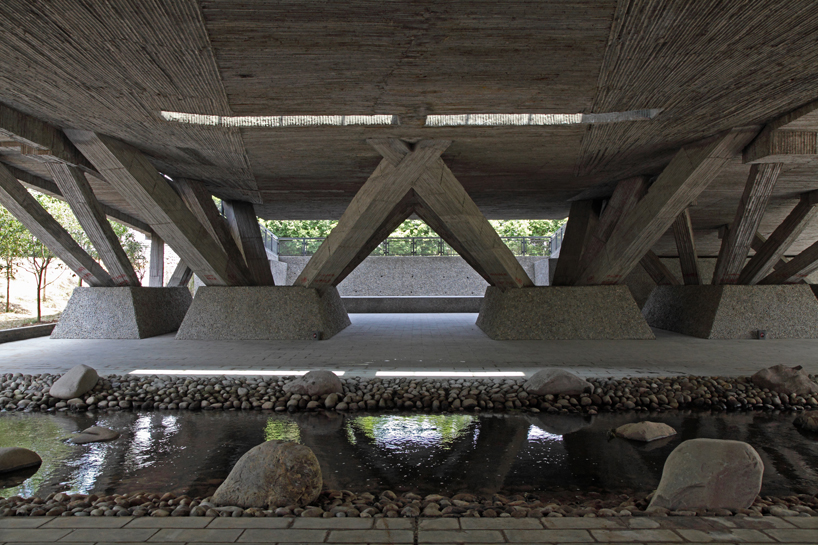 river passes beneath the museum image © cao, yang
river passes beneath the museum image © cao, yang
DB: is there somebody you have studied in depth which you feel close to or are most interested in the work of?
YHC: I know architects who aren’t probably the biggest names in the industry, although I have to say a lot of them are very well-known anyway. just because they’re not ‘spectacular’, people don’t pay as much attention to them. for these architects, there’s always a sense of craft, something you can see is somewhere even when it’s not there. it’s still interesting.
lewerentz (sigurd) is a hero for me because now as I am a little older and more experienced when I go to a construction site, people respect me more. you know the story when lewerentz goes to a construction site and all the laborers and workers take off their hats to salute him, not because he could draw, but he could lay bricks better than his workers. he knew how to make a mortar joint that wide (indicates dimensions by hand), to make a turn in which you didn’t need to cut the brick. so he was a craftsman. I don’t know if I am ever going to be one, so he is a hero. today there are people like peter zumthor and there are a couple of people whose buildings I have not seen in real life such as geoffrey bawa.
if there’s one architect in asia who’s my role model, it is bawa. he’s from an elite family in sri lanka who went to public school in england and studied law. he became interested in architecture, so his whole eduction was done in the UK, and when he returned to sri lanka, he constructed buildings with a really thorough understanding of the local culture, the climate and other conditions… just really fantastic.
 ‘shanghai corporate pavilion’ in shanghai, china image courtesy of atelier FCJZ and nic lehoux see more info about this project here
‘shanghai corporate pavilion’ in shanghai, china image courtesy of atelier FCJZ and nic lehoux see more info about this project here
DB: which project has given you the most satisfaction?
YHC: I think my better work would probably be produced here in china because I have only been practicing 18 or 19 years, and I am just starting to understand this place. when I was young I understood china, but in a very different way. I understood chinese culture, but I didn’t know other cultures. I felt like I was an onlooker. I was part of it because there was no need for me to understand more than what I did. I was young and naive and immature, but today I feel like I have started to understand something deeper.
there are two which have opened my eyes a bit. the first is the ‘split house’, a large commune by the great wall of china. I grew up in a courtyard house and it’s the home I spent the most time and I loved it because it knew it better than any other house. with this, I wanted to build one in this open landscape in the hills, and of course again after much trial and error, I realized the structure was very urban and did not make sense in its proposed context – a house totally enclosed in the open landscape – so I built two wings into the slope of the hill, making a courtyard semi-enclosed both man made and defined by nature – rammed earth. through all our projects we learn our technologies not from the locals. I have realized that there is no such thing as old technology, traditional technology or new technology.
it’s whatever technology available that makes sense is the right one. I don’t really consider that a person using timber is dealing with tradition. we always learn from tradition so how would you do a timber structure today? that is the more important question. I also don’t believe in importing anything, so that’s why we use the rammed earth technique and then we use fiberglass as if we’re totally schizophrenic, but we’re not. they’re both available to us – earth is there and so is plastic to use.
the other project is the flat clubhouse. it’s also a residential community where we brought back a lot of traditional elements because it’s on the waterfront in the shanghai region, and there are a lot of wisdoms revolving around living with water which have been forgotten. there’s one thing that I learned from doing that project and again it has to do with the courtyard prototype that’s chinese. you have a piece of land, and you have a building right in the middle that’s western. of course I’m making a cartoon of the thing. it’s a caricature, but you know you couldn’t help to think you have american suburbia, with cookie cutter houses. and then if you’re going to make a chinese community, you can have back-to-back courtyard houses… but luckily neither worked on the site, so we ended up developing a kind of consolidated house, with lakes coming out of it forming small courtyards. something between east and west that didn’t really exist and that made me think that I want to do more of it. I want to create more architecture because there are new possibilities. I’m not very good at making exaggerated forms. that’s not me, but I can do different architecture and still have a sense of discovery. that’s what is satisfying.
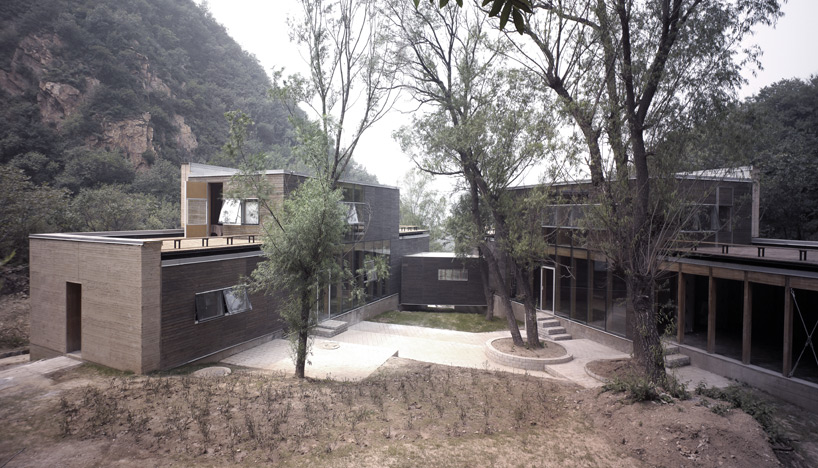 ‘split house’
‘split house’
DB: has there been an evolution in your work from the beginning when you first started your practice to what you’re doing now?
YHC: I have some moments of ambition from time to time where I say, let’s do something beyond the basics of architecture… but I always come back to it. I guess this is my fate. it’s always the material the space, how people live… I am interested in the tangibility of architecture – more the everyday rather than some more profound idea about architecture. so now, after almost 20 years, I may just settle rather than find some more acute idea about architecture. in this way I can always settle on the basics. although some materials can get radical, it’s still about materials, so the making of the other extreme craft. I’m working with a very young architect MIT, and we both share this notion that there is a person beyond the machine. you can still introduce a sense of craft even when you do digital fabrication.
 yung ho chang talking about the ‘FRP house’ at the firm’s studio in beijing image © designboom
yung ho chang talking about the ‘FRP house’ at the firm’s studio in beijing image © designboom
 testing of structure for the ‘FRP house’ see more info about this project here
testing of structure for the ‘FRP house’ see more info about this project here
 rendering of the ‘FRP house’ in nanjing, china
rendering of the ‘FRP house’ in nanjing, china
 process of design and structural testing for the ‘FRP house’
process of design and structural testing for the ‘FRP house’
DB: do you teach?
YHC: I do, at the MIT in boston. I enjoy teaching but I think I should stop soon. it’s a little too far.at one point I was the department head at MIT for architecture for five years and looking back now, I don’t know how I did it.
DB: what advice would you give to the young?
YHC: I believe architecture is something more down to earth, and ultimately relates to how people live.although I’ve done my share in some way, I don’t think architects can just fly around and build structures anywhere, but rather they need to anchor themselves in one place. for example, you say italian architects can still be the marco polos of today, and come to beijing and stay for a year…and then there are actually italian architects here, working and so on…but I’m suspicious of global practice. they may produce a very glorious kind of architecture, but it’s not architecture that would belong somewhere. that being said, I think jet setters is very much a result of evolution. when I was younger, I remember I was so envious seeing the stars of my days talking about doing little sketches on their flights between locations, and that was the time for the architect to be creative. now I would say what a lousy idea. you should really sit in your studio and work with materials and with your team.
 on hand materials at the practice’s studio image © designboom
on hand materials at the practice’s studio image © designboom
 mock-up of the ‘glass chapel’ at atelier FCJZ’s beijing studio see more info about this project here
mock-up of the ‘glass chapel’ at atelier FCJZ’s beijing studio see more info about this project here
 detail of ‘glass chapel’ mock-up in the garden at atelier FCJZ’s beijing studio image © designboom
detail of ‘glass chapel’ mock-up in the garden at atelier FCJZ’s beijing studio image © designboom
 rendering of the ‘glass chapel’
rendering of the ‘glass chapel’
yung ho chang answering the question ‘what are you afraid of regarding the future?’ video © designboom
DB: is there something you’re afraid of regarding the future?
YHC: although my concerns revolve around china, I think I can say on the social and environmental front I am optimistic. socially speaking, I think that society is developed out of balance. income discrepancy, the way people have been losing a sense of community and mutual trust since the cultural revolution, would have all been big potential problems for the country… on an environmental front for the last year, I think a very dear price has been paid to achieve the kind of economic success we have today. there is absolutely an over use of resources and the creation of solution and so on.
I am not a public intellectual. I don’t really voice my opinions because they are kind of simple, but I hope through my work as an architect I could help a little bit to say that in a creative public space, that in a city not every piece of land is privatized… I have this crazy idea. I don’t know if it will really work, but my clients like it… in a community today, especially if you live in a house, people don’t really know each other. you have your own little territory – he has his and she has hers – and so on and so I have this idea to create a ‘neighbour room’ in the house – a piece of small but public space in the house where you put a ping pong table so your neighbour can pass by and see it. you can invite him to come and play and then in another house the ‘neighbour room’ is for playing mahjong etc. I don’t know if this would work but the client thought the idea was interesting so I am going to pursue it. although probably for the upper middle class, it’s things like this people need to live and socialize in a community, and it’s humorous at the same time.
for me, architecture is like medicine. we have a lot of responsibilities. here in this country when my father was an architect, people didn’t understand what that profession was. they thought we were engineers. today people don’t know what we do. they think we’re artists. you know we have pretty flamboyant architects and so on, and they talk about great ideas, but I think that really we are architects, in a way engineers, kind of artists, but we are probably most like doctors. we have a license to practice because of responsibility.
— born in beijing, china, yung ho chang received his bachelor of science in environmental design from ball state university and his master of architecture from the university of california at berkeley along with his initial education at the nanjing institute of technology in china. he has taught in both china and the US since receiving his degrees, including each of his alma maters, rice university, university of michigan, harvard and tongi university for 15 years. he taught and headed MIT’s architecture department from 2005 to 2010 and since 1999, he founded and headed the program at peking university. in 1992 he returned to beijing to found atelier feichang jianzhu, atelier FCJZ a year later.
he has received the progressive architecture citation award in 1996, 2000 UNESCO prize for the promotion of arts, participated in five venice architecture biennales and served on the jury for the pritzker prize.
architecture interviews (277)
atelier FCJZ (34)
PRODUCT LIBRARY
a diverse digital database that acts as a valuable guide in gaining insight and information about a product directly from the manufacturer, and serves as a rich reference point in developing a project or scheme.


